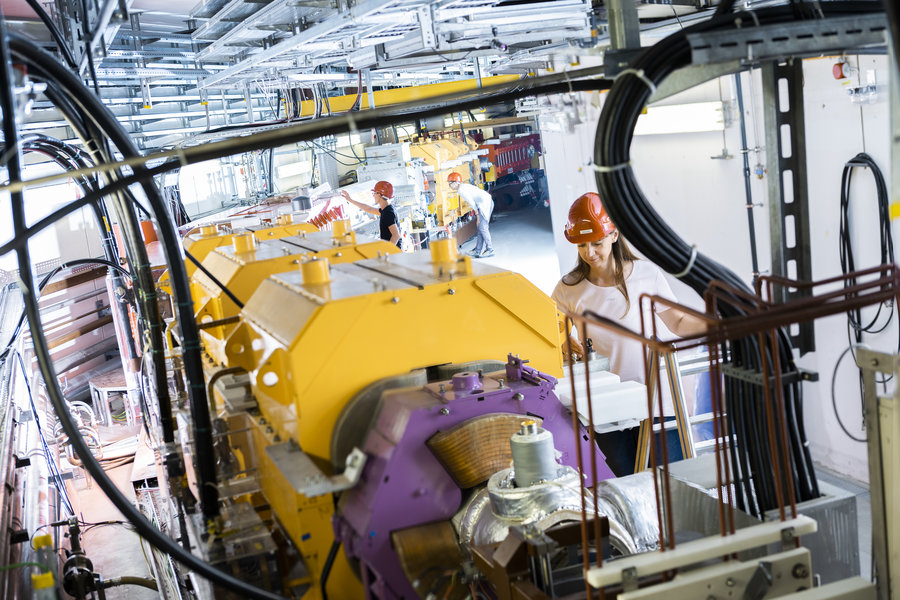Italian-German scientific cooperation: CNAO in Pavia receives funding of more than 385,000 euros for a joint research project with GSI in Darmstadt
05.12.2023 |
This news is based on a press release by the National Center for Oncological Hadron Therapy CNAO, Pavia, Italy.
Two of Europe's leading centers for the study and application of heavy particles in oncology will partner in the “CROSS” project to investigate for the first time in living organisms whether the sequence of carbon ions followed by photons is more effective in treating radioresistant tumors than the reverse order of irradiation. The study is part of a long-standing collaboration in which the National Center for Oncological Hadron Therapy CNAO in Pavia and the GSI Helmholtzzentrum für Schwerionenforschung in Darmstadt are involved in several other joint research projects.
CNAO has received a grant of 385,600 euros from the Italian Ministry of Foreign Affairs and International Cooperation (MAECI) as part of a call for proposals aimed at facilitating access for Italian researchers to certain cutting-edge scientific infrastructures in Germany that are not available in Italy. Thanks to the grant, a group of CNAO scientists will have access to the GSI Helmholtzzentrum für Schwerionenforschung in Darmstadt, a world-leading center for radiobiological research, providing an accelerator facility also able to perform in vivo experiments. The CNAO scientists will be supervised and supported by the team of Professor Marco Durante, Director of GSI’s Biophysics Department and one of the leading international experts in radiobiology and medical physics.
The research project, the MAECI grant was awarded for, is called “CROSS” (Combination of X-Ray and Carbon-iOns for radioresiStant tumorS) and aims to investigate whether mixed-beam radiotherapy with carbon ions followed by photons is more effective than the reverse sequence (photons followed by carbon ions) in a mouse model of osteosarcoma, a radioresistant tumor.
“There are different clinical experiences with the treatment of radioresistant tumors with mixed beams,” explains Amelia Barcellini, principal investigator of the study, radiotherapist at CNAO and PhD student at the University of Pavia in the Experimental Medicine program. “In this type of neoplasia (i.e. new formation of body tissue), an early boost with carbon ions before photon treatment is preferred in clinical practice in order to take advantage of the radiobiological benefits of the particles and thus increase the sensitivity of the tumor to the second part of radiotherapy with photons. However, the current preclinical data are not sufficient to prove that this sequence is the better one. CROSS will evaluate for the first time in an in vivo experiment the difference between the two sequences (carbon ions + X-rays versus X-rays + carbon ions) in terms of tumor response, immunogenicity, hypoxia and toxicity”.
“Our hypothesis is that the use of carbon ions at the beginning of treatment is the most effective strategy,” says Angelica Facoetti, Head of Experimental Radiobiology at CNAO. “In vitro evidence suggests that by stimulating the anti-tumor activity of the immune system, causing irreparable DNA damage to neoplastic cells and promoting cellular re-oxygenation, carbon ions could 'pave the way' and optimize the effect of subsequent X-ray irradiation.”
“The collaboration with CNAO is strategic for the GSI’s Biophysics Department and a win-win situation. We have the best possible research infrastructure, while CNAO is an advanced clinical center for carbon ion treatment,” stresses Professor Marco Durante. “In the project CROSS we try to answer a simple question: when patients are treated with conventional X-rays fractionated course and a boost of carbon ions, is it better to apply the boost before or after X-rays? Even if the boost is sometimes given at the end, we have reasons to believe that starting with carbon can be preferable, as it may trigger a strong re-oxygenation. The experiment will run already in the February 2024 block of FAIR-phase-0 and we expect exciting results with a strong translational potential in the CNAO clinic. By working together, we can achieve outstanding results that have an international impact and benefit society in Europe and the whole world in the fight against cancer.”
CNAO and GSI have been actively collaborating in the field of scientific research since the center was founded in Pavia. Both are participating in the HITRIplus (Heavy Ion Therapy Research Integration Plus) project, which is funded by the European Union's Horizon 2020 program and whose coordinator is CNAO. The FOOT experiment (FragmentatiOn Of Target) is one of the many other collaborations in which the two partners are involved. It aims to analyze how protons and carbon ions break up nuclei in the human body to damage and kill cancer cells.
Thanks to the CROSS project and the grant received, CNAO and GSI have established a new preclinical research consortium that will enable multidisciplinary collaboration between radiobiology, biophysics and medicine in the treatment of tumors with heavy ions. This will enable important progress to be made in the field of radiation therapy with mixed beams. (CNAO/BP)
Further information
CNAO, National Center for Oncological Hadron Therapy
Project HITRIPlus: Heavy Ion Therapy Research Integration
FOOT Experiment FragmentatiOn Of Target












